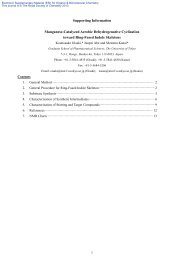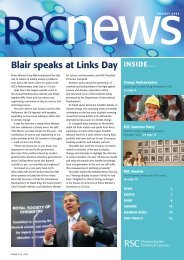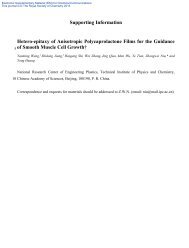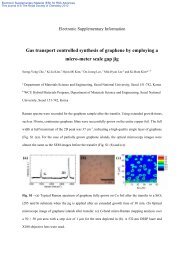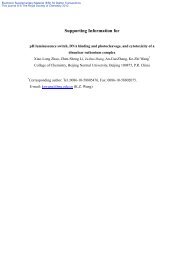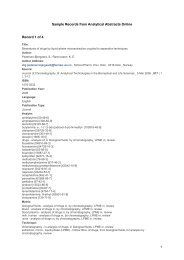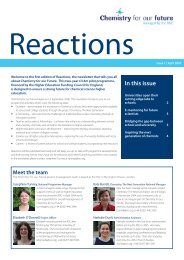Synthetic biology Seminar Report(New). - Royal Society of Chemistry
Synthetic biology Seminar Report(New). - Royal Society of Chemistry
Synthetic biology Seminar Report(New). - Royal Society of Chemistry
Create successful ePaper yourself
Turn your PDF publications into a flip-book with our unique Google optimized e-Paper software.
<strong>Royal</strong> <strong>Society</strong> <strong>of</strong> <strong>Chemistry</strong><br />
Registered Charity Number: 207890<br />
Burlington House<br />
Piccadilly<br />
London W1J 0BA<br />
UK<br />
Tel: +44 (0)20 7437 8656<br />
Fax: +44 (0)20 7734 1227<br />
Email: sciencepolicy@rsc.org<br />
www.rsc.org
Engineering Life<br />
The emerging field <strong>of</strong> synthetic <strong>biology</strong><br />
www.rsc.org
<strong>Synthetic</strong> <strong>biology</strong> is a new, rapidly developing and potentially controversial area<br />
<strong>of</strong> interdisciplinary research. A quantitative field that aims to design, model and<br />
construct new biological systems to carry out novel tasks, synthetic <strong>biology</strong> takes a<br />
rigorous engineering approach to biological systems.<br />
Researchers suggest that this emerging field could <strong>of</strong>fer societal, medical<br />
and environmental benefits. However, the ethical and social implications are<br />
considerable, and there is an ongoing discussion regarding whether current<br />
regulations are sufficient to address all potential outcomes <strong>of</strong> work in this area.<br />
Scientists from engineering, physics, chemistry and <strong>biology</strong> are increasingly engaged<br />
in synthetic <strong>biology</strong>. For synthetic <strong>biology</strong> research and industry to flourish in the UK,<br />
research capacity, education and training need considerable expansion.<br />
To understand the emerging field <strong>of</strong><br />
synthetic <strong>biology</strong>, the <strong>Royal</strong> <strong>Society</strong> <strong>of</strong><br />
<strong>Chemistry</strong> held a seminar, in collaboration<br />
with the Institute <strong>of</strong> Physics and the<br />
Institute <strong>of</strong> Biology, to discuss the evidence<br />
on 24 April 2008. Pr<strong>of</strong>essor John McCarthy,<br />
chair <strong>of</strong> the RSC’s <strong>Chemistry</strong><br />
Biology Interface Forum and<br />
Director <strong>of</strong> the Manchester<br />
Interdisciplinary Biocentre,<br />
chaired the meeting.<br />
Dr Philipp Holliger,<br />
Programme Leader at the MRC<br />
Laboratory <strong>of</strong> Molecular Biology<br />
outlined the science behind<br />
synthetic <strong>biology</strong>. Pr<strong>of</strong>essor Richard Kitney<br />
OBE, Pr<strong>of</strong>essor <strong>of</strong> BioMedical Systems<br />
Engineering and Chairman <strong>of</strong> the Institute<br />
<strong>of</strong> Systems and <strong>Synthetic</strong> Biology at<br />
Imperial College London, discussed current<br />
research capacity, funding and support<br />
for synthetic <strong>biology</strong> in the UK. Pr<strong>of</strong>essor<br />
Brian Wynne, Associate Director <strong>of</strong> the ESRC<br />
Centre for Economic and Social Aspects <strong>of</strong><br />
Genomics addressed the social and ethical<br />
issues.<br />
The origins <strong>of</strong> synthetic <strong>biology</strong><br />
Watson and Crick’s publication <strong>of</strong> the<br />
structure <strong>of</strong> DNA in Nature in 1953 marked<br />
the first phase <strong>of</strong> the molecular <strong>biology</strong><br />
revolution. The sequencing <strong>of</strong> the human<br />
genome in 2001 represented a further<br />
major milestone, although already in 1978,<br />
the Nobel Prize in Physiology or Medicine<br />
was awarded to Werner Arber, Dan Nathans<br />
and Hamilton Smith<br />
for the discovery <strong>of</strong><br />
restriction enzymes,<br />
“chemical knives”<br />
that can be used to<br />
cut DNA into defined<br />
fragments and are a<br />
key tool for synthetic<br />
biologists. Polish<br />
geneticist Waclaw Szybalski commented<br />
that their discovery opened up “the new era<br />
<strong>of</strong> synthetic <strong>biology</strong> where not only existing<br />
genes are described and analysed but also<br />
new gene arrangements can be constructed<br />
and evaluated.” 1<br />
‘Potential applications likely<br />
to benefit from synthetic<br />
<strong>biology</strong> include bi<strong>of</strong>uels,<br />
biosensors, biomaterials,<br />
therapeutics’<br />
A quantitative approach<br />
Historically, <strong>biology</strong> has been a descriptive,<br />
qualitative science, using a reductionist<br />
approach to categorize and explain living<br />
systems. Emerging during the 20 th century,<br />
quantitative <strong>biology</strong> has more in common<br />
with physical science and engineering in<br />
its approach to modelling systems. Indeed,<br />
the most pervasive manifestation <strong>of</strong> this<br />
trend, systems <strong>biology</strong>, evaluates the<br />
emergent properties <strong>of</strong> biological systems<br />
in terms <strong>of</strong> integrative computational<br />
models.<br />
<strong>Synthetic</strong> <strong>biology</strong> aims to go beyond<br />
this analysis to the synthesis <strong>of</strong> complex<br />
biological based or biologically inspired<br />
systems to display functions that<br />
either mimic nature or that go beyond<br />
nature. Paraphrasing G.B. Shaw’s Back<br />
to Methusalem, Holliger says that where<br />
traditional <strong>biology</strong> looks at things that are,<br />
and ask the question: “Why?” <strong>Synthetic</strong><br />
biologists like to dream <strong>of</strong> things that never<br />
were, and say: “Why not?”<br />
Models derived from systems <strong>biology</strong><br />
form the basis for engineering novel<br />
systems, i.e. synthetic <strong>biology</strong>. To<br />
understand living systems in detail, it is<br />
fundamental that the models should<br />
predict behaviour that researchers can<br />
test, according to McCarthy. Biosystems<br />
studies increasingly depend on inputs from<br />
computing to the physical sciences and<br />
engineering.<br />
Living systems comprise diverse<br />
molecules engaged in interactions that<br />
give rise to various levels <strong>of</strong> complexity.<br />
Small molecules and macromolecules<br />
| Engineering life
Escherichia coli (E.coli) a bacterium found in the lower intestine<br />
interact to form complexes. These interact<br />
structurally and functionally forming<br />
pathways and circuits responsible, for<br />
example, for metabolic reactions catalysed<br />
by enzymes. At the next level, huge<br />
gene networks form between biological<br />
molecules in living cells. A quantitative<br />
approach goes beyond categorising<br />
these molecules and instead studies their<br />
complex interactions. The combined<br />
effect is <strong>of</strong>ten greater than the sum <strong>of</strong><br />
individual interactions – this is known<br />
as “emergent behaviour.”<br />
<strong>Synthetic</strong> <strong>biology</strong> has a<br />
value as a pure science in<br />
adding to the fundamental<br />
understanding <strong>of</strong> biological<br />
systems. Potential<br />
applications likely to benefit<br />
from synthetic <strong>biology</strong> include bi<strong>of</strong>uels,<br />
biosensors, biomaterials, therapeutics, and<br />
ultimately, hybrid devices - engineered<br />
systems that integrate biological and<br />
non-biological components. In the next<br />
decade, organisms and biomolecules with<br />
greatly expanded chemistry will provide<br />
materials and even evolutionary processes<br />
to nanotechnology and materials science,<br />
and allow the synthesis <strong>of</strong> novel nucleic<br />
acid and protein-based drugs. Other<br />
applications include bioremediation for<br />
the cleanup <strong>of</strong> toxic spills, targeted tissue<br />
regeneration, and search and destroy<br />
vehicles to target disease.<br />
Exponential progress<br />
The rate <strong>of</strong> progress in DNA sequencing<br />
and synthesis has been likened to the<br />
computer industry, where processor<br />
capacity per unit cost doubles roughly<br />
every two years - a phenomenon known as<br />
Moore’s Law. Sequencing the first human<br />
genome took ten years<br />
and cost $3 billion. In<br />
February 2008, the<br />
Californian company<br />
Illumina claimed it had<br />
sequenced a human<br />
genome in less than four<br />
weeks for approximately $100,000 2 .<br />
Although the computing analogy is<br />
helpful in developing hierarchies and<br />
breaking down complex systems into<br />
manageable subsystems, it has limitations.<br />
Holliger suggests we know much less<br />
about complex dependency and how<br />
parts really function together within a cell<br />
than we do about computer chips. How<br />
a biosynthetic device functions, and if it<br />
functions at all, may depend heavily on<br />
‘known as biobricks or<br />
bioparts, parts are typically<br />
placed in cells like E. coli, to<br />
produce devices’<br />
the genetic make up <strong>of</strong> the host cell, its<br />
metabolic state, and even on the location<br />
<strong>of</strong> various elements within the genome.<br />
Technological advances in high<br />
throughput sequencing and gene<br />
synthesis provide the building blocks<br />
for synthetic <strong>biology</strong>. One example <strong>of</strong> a<br />
new property engineered by rearranging<br />
the building blocks from two organisms<br />
is bacterial photography. E. coli is a gut<br />
bacterium used to living in the dark, but<br />
researchers added a light sensor from<br />
the photosynthetic cyanobacterium,<br />
Synechosystis. A further E. coli gene was<br />
swapped for one that triggers enzyme<br />
expression leading to synthesis <strong>of</strong> a black<br />
pigment. A layer <strong>of</strong> these bacteria now<br />
forms photographic film with resolution <strong>of</strong><br />
up to 100 mega pixels when the bacterial<br />
switches are triggered by light.<br />
Further examples <strong>of</strong> the building block<br />
approach include work towards creating<br />
cancer invading bacteria or “biobots.”<br />
The low oxygen environments typical<br />
<strong>of</strong> tumours in the body switch on an<br />
invasion gene, prompting the bacteria to<br />
invade cancer cells. This potential selective<br />
delivery mechanism for anti-cancer drugs<br />
shows how cellular behaviour can be<br />
programmed through signalling cascades<br />
Engineering life |
triggered by environmental cues. Other<br />
applications include tissue remodelling<br />
with genetic programmes that might be<br />
integrated into stem cells.<br />
Drugs synthesised by engineered<br />
microbes could be cheaper to produce.<br />
The anti-malarial drug artemisinin derived<br />
from sweet wormwood is expensive and<br />
difficult to obtain by conventional organic<br />
chemistry. E. coli and bakers’ yeast can<br />
provide a faster path to precursor artemesic<br />
acid in ever increasing yields, greatly<br />
reducing artemesinin production costs.<br />
To overcome complex dependence on<br />
the host organism, synthetic biologists<br />
employ several strategies. One is to<br />
decouple a genetic system or device from<br />
host-cell interactions and is known as<br />
orthogonality. A functionally orthogonal<br />
pair - a tRNA/synthetase pair that react<br />
together but not with endogenous<br />
organism pairs - is evolved to selectively<br />
accept unnatural amino acids. Almost all<br />
known forms <strong>of</strong> life use the same common<br />
20 amino acids to make proteins. Such<br />
technologies allow the chemistry set <strong>of</strong><br />
proteins to be expanded from 20 amino<br />
acids to many more. Synthesis <strong>of</strong> proteins<br />
with unnatural amino acids has many<br />
applications both in scientific investigation<br />
and pharmacology. Using these building<br />
blocks, researchers can reprogramme cell<br />
behaviour to create new phenotypes.<br />
A more radical, “top down” approach<br />
to reduce complex dependence involves<br />
stripping unnecessary elements from a<br />
genome. For instance, researchers have<br />
reduced the E. coli genome by about 15<br />
percent. The result is a strain much more<br />
stable for genetic experiments.<br />
“Bottom up” approaches include building<br />
systems with lifelike properties such as<br />
growth, reproduction and adaptation from<br />
simple components. Directed evolution<br />
is an approach that allows synthetic<br />
biologists to explore functions that don’t<br />
require a natural environment, for which<br />
they may not even understand the<br />
molecular basis. A powerful technique,<br />
directed evolution creates novel functions<br />
in synthetic <strong>biology</strong>, and is central to<br />
efforts to expand the chemistry that can<br />
be encoded within DNA. Examples include<br />
compartmentalized self-replication (CSR),<br />
where a polymerase replicates only its<br />
own encoding gene. The<br />
reactions take place in an<br />
emulsion comprised <strong>of</strong><br />
water droplets suspended in<br />
oil, creating compartments<br />
akin to artificial cells. This<br />
technique can be used to create new forms<br />
<strong>of</strong> DNA such as those soluble in liquids<br />
other than water. Holliger suggests that<br />
expanding the chemistry <strong>of</strong> the molecules<br />
<strong>of</strong> life has exciting applications, for example,<br />
in nanotechnology and materials science.<br />
Drugs synthesised by engineered microbes could be cheaper to produce<br />
DNA is a particularly attractive material<br />
to construct nanostructures and devices,<br />
because synthetic biologists can control its<br />
make-up with atomic precision.<br />
Engineering synthetic life<br />
An important question concerns whether<br />
we can synthesise life itself, and if so<br />
whether this would provide answers<br />
about how life began.<br />
Experiments to make<br />
prototype cells (protocells)<br />
containing self-replicating<br />
RNA address this question.<br />
These quasi-biological<br />
systems would be capable <strong>of</strong> growth,<br />
division, and evolution. These would<br />
still be greatly dependent on being “fed”<br />
chemicals, but might manifest certain<br />
features <strong>of</strong> living systems.<br />
Kitney outlined how synthetic biologists<br />
‘...considerable investment<br />
over the last five years puts<br />
the US at the forefront <strong>of</strong><br />
synthetic <strong>biology</strong>’<br />
apply engineering and physical science<br />
design approaches to <strong>biology</strong>. Engineering<br />
systems are built from a hierarchy<br />
comprising parts, devices and systems.<br />
Characteristics at each <strong>of</strong> these levels are<br />
well defined and reproducible.<br />
The engineering cycle involving detailed<br />
modelling, design, implementation, testing<br />
and then further modelling is now being<br />
applied in synthetic <strong>biology</strong>. <strong>Synthetic</strong><br />
biologists aim to build a device, or system,<br />
from standard parts. Sometimes known<br />
as biobricks or bioparts, these parts are<br />
typically placed in cells like E. coli, to<br />
produce devices, all <strong>of</strong> which are currently<br />
relatively simple and on the nanoscale.<br />
Biobricks:<br />
• Parts – encode biological functions<br />
(<strong>of</strong>ten modified bacterial DNA)<br />
• Devices – made from a collection <strong>of</strong><br />
| Engineering life
funding worth $16<br />
million over five years for<br />
a new synthetic <strong>biology</strong><br />
centre at the University<br />
<strong>of</strong> California at Berkeley 5 ,<br />
launched in 2006. BP has<br />
invested $500 million to<br />
fund research into new<br />
forms <strong>of</strong> energy, using synthetic <strong>biology</strong>,<br />
through a consortium led by UC Berkeley,<br />
to which the Gates Foundation is another<br />
contributor. Research at the Whitehead<br />
Institute at the Massachusetts Institute <strong>of</strong><br />
Technology is also notable 6 .<br />
US biologist and businessman J. Craig<br />
Venter was instrumental in mapping the<br />
human genome. Venter’s own DNA is the<br />
subject <strong>of</strong> the first complete (six-billionletter)<br />
genome <strong>of</strong> an individual human. He<br />
is also seeking to patent the first humancreated<br />
life form. The new J. Craig Venter<br />
Institute was formed in October 2006<br />
through the merger <strong>of</strong> several affiliated<br />
and legacy organizations. In addition to<br />
genomics, the Institute studies the societal<br />
implications <strong>of</strong> its research. Research<br />
involves clean energy, synthetic <strong>biology</strong>,<br />
ethics, law, and economics. The Institute<br />
employs over 400 people, including Nobel<br />
laureate Hamilton Smith.<br />
In the UK a three-year inquiry into<br />
systems <strong>biology</strong> (also incorporating<br />
synthetic <strong>biology</strong>) by the Academy <strong>of</strong><br />
Medical Sciences and The <strong>Royal</strong> Academy<br />
<strong>of</strong> Engineering 7 published in 2007 had four<br />
main recommendations.<br />
These were:<br />
• to establish a number <strong>of</strong> new major<br />
systems and synthetic <strong>biology</strong> centres in<br />
the UK;<br />
• additional investment;<br />
• to create an interdisciplinary research<br />
environment;<br />
• to foster interdisciplinary skills and create<br />
interdisciplinary research environments.<br />
parts, these encode human-defined<br />
functions (e.g. logic gates)<br />
• Systems – perform tasks (e.g. counting)<br />
Specification sheets<br />
for standard parts are<br />
listed on the MIT registry<br />
website 3 . Currently<br />
there are some 800<br />
standard parts listed. The<br />
international Genetically<br />
Engineered Machine competition (iGEM)<br />
is an international arena where student<br />
teams compete to design and assemble<br />
engineered machines using advanced<br />
genetic components and technologies 4 .<br />
Funding<br />
<strong>Synthetic</strong> <strong>biology</strong> research within US<br />
universities is particularly strong and<br />
considerable investment over the last<br />
‘Academic organisation,<br />
funding streams and research<br />
assessment mechanisms<br />
must evolve to encourage the<br />
growth <strong>of</strong> interdisciplinary<br />
research...’<br />
five years puts the US at the forefront<br />
<strong>of</strong> synthetic <strong>biology</strong>. For instance, the<br />
National Science Foundation contributed<br />
The new centres should be located<br />
within leading universities internationally<br />
competitive in <strong>biology</strong>, medicine,<br />
engineering and physical sciences research.<br />
They must be a focus <strong>of</strong> activity effectively<br />
networked to smaller centres in other<br />
universities, including those currently being<br />
established by the BBSRC and the EPSRC,<br />
and linked to international initiatives. An<br />
investment <strong>of</strong> approximately £325 million<br />
is required over a period <strong>of</strong> 10 years to<br />
establish three to five new centres.<br />
The interdisciplinarity <strong>of</strong> systems <strong>biology</strong><br />
poses a challenge to the traditional<br />
university department structures and the<br />
current arrangements <strong>of</strong> research grants<br />
committees in the public, private and<br />
charity sectors. Academic organisation,<br />
funding streams and research assessment<br />
mechanisms must evolve to encourage<br />
growth <strong>of</strong> interdisciplinary research<br />
activities such as systems <strong>biology</strong>. This<br />
means a substantial change in culture, in<br />
which <strong>biology</strong> and medicine become more<br />
quantitative. “Universities must break down<br />
barriers between disciplines and consider new<br />
methods <strong>of</strong> organisation that promote novel<br />
scientific approaches,” Kitney suggests.<br />
Given the urgent need to develop the<br />
necessary skills required for systems and<br />
synthetic <strong>biology</strong>, universities should<br />
create new postgraduate courses and<br />
expand postdoctoral opportunities.<br />
Undergraduates, including medical<br />
students, should be <strong>of</strong>fered options in<br />
the core disciplines that support systems<br />
<strong>biology</strong>, as well as increased exposure to<br />
interdisciplinary problems and modules.<br />
Engineering life |
Courses in <strong>biology</strong> and medicine for<br />
engineers, mathematicians and physical<br />
scientists must be combined with an<br />
expansion <strong>of</strong> mathematical training for<br />
biological and medical scientists to develop<br />
multi-skilled, interdisciplinary teams. In<br />
view <strong>of</strong> the shortage <strong>of</strong> trained personnel<br />
in the UK, overseas recruitment may be<br />
necessary.<br />
Bodies such as the <strong>Royal</strong> <strong>Society</strong> are<br />
actively engaged in reviews and discussion<br />
groups on synthetic <strong>biology</strong>, and research<br />
councils are moving to ensure that funding<br />
is available.<br />
The BBSRC has already set up six systems<br />
<strong>biology</strong> centres, along with Engineering<br />
and Biological Systems Grants and<br />
<strong>Synthetic</strong> Biology Network Grants 2008<br />
(with EPSRC). The EPSRC will also invest<br />
£3-5 million in one or two universities<br />
to underpin synthetic <strong>biology</strong>, and fund<br />
grants. UK universities leading synthetic<br />
<strong>biology</strong> research include Imperial College<br />
London, and the Universities <strong>of</strong> Cambridge,<br />
Edinburgh, Glasgow and Manchester.<br />
A number <strong>of</strong> these are developing<br />
undergraduate and postgraduate courses<br />
in synthetic <strong>biology</strong>.<br />
The ESRC also funds three centres on<br />
genomics-related social, scientific, and<br />
ethical scientific research: Centre for Social<br />
and Economic Research on Innovation in<br />
Genomics (Innogen) at the University <strong>of</strong><br />
Edinburgh, Centre for Genomics in <strong>Society</strong><br />
(Egenis) at the University <strong>of</strong> Exeter and<br />
Centre for Economic and Social Aspects<br />
<strong>of</strong> Genomics (CESAGen) at Lancaster and<br />
Cardiff Universities. In addition, it funds<br />
a Genomics forum and a considerable<br />
amount <strong>of</strong> responsive-mode research<br />
in various UK universities. Much <strong>of</strong> this<br />
and the Centre’s research is with natural<br />
sciences partners.<br />
The European Union has funded several<br />
projects under <strong>New</strong> and Emerging Science<br />
and Technologies 8 (NEST) within the<br />
Sixth Framework Programme (FP6), and<br />
further support is likely under FP7 as part<br />
<strong>of</strong> health and biotechnology themes. One<br />
example under NEST is TESSY 9 , a series<br />
<strong>of</strong> expert workshops and other activities<br />
to coordinate research activities that are<br />
currently scattered across European regions<br />
and scientific disciplines.<br />
DNA is an attractive<br />
material to construct<br />
nanostructures and devices,<br />
because synthetic biologists<br />
can control its makeup with<br />
atomic precision<br />
A third industrial revolution?<br />
Kitney argued that the confluence <strong>of</strong><br />
<strong>biology</strong>, engineering, and physical science<br />
in synthetic <strong>biology</strong> will result in a third<br />
industrial revolution over the next 50<br />
years. He cited strong parallels with the<br />
emergence <strong>of</strong> synthetic chemistry in the<br />
19 th century, when chemists moved from<br />
studying natural chemicals to creating<br />
synthetic chemicals, such as aspirin,<br />
quinine and mauve dye.<br />
Although the complexity <strong>of</strong> biological<br />
| Engineering life
systems suggests extremely tough<br />
challenges for synthetic biologists to<br />
overcome, many engineering problems<br />
involve great complexity. For instance,<br />
the latest Intel chip features two billion<br />
transistors. The UK and Europe need to<br />
establish the required research capacity<br />
funding to meet these challenges.<br />
Controversy and risk<br />
Discussions about the possibility <strong>of</strong><br />
creating living organisms have been aired<br />
in the media. In particular, excitement and<br />
concern surround Craig Venter’s work in<br />
synthesising whole genomes, leading to<br />
comments in the press that he is “playing<br />
God.” 10 This work involves synthesising a<br />
genome for an organism<br />
with just over 500 genes<br />
(a human cell has around<br />
25,000 genes). However,<br />
although genes may<br />
represent the blueprint for<br />
a cell, it is important to draw a distinction<br />
between creating a genome and a living<br />
cell in its entirety.<br />
<strong>Synthetic</strong> <strong>biology</strong> poses a new set <strong>of</strong><br />
social and ethical concerns articulated by<br />
various parties, including some scientists,<br />
and examined by the social sciences and<br />
humanities. Some question the adequacy <strong>of</strong><br />
scientific regulation and risk assessment as<br />
a means <strong>of</strong> understanding, anticipating and<br />
hopefully managing the kinds <strong>of</strong> futures<br />
synthetic <strong>biology</strong> is generating.<br />
Wynne highlights the reasons for<br />
these questions about the intellectual<br />
capacity <strong>of</strong> risk assessment to predict<br />
the consequences <strong>of</strong> advances in fields<br />
like synthetic <strong>biology</strong>. Where the pace<br />
<strong>of</strong> scientific change, and particularly <strong>of</strong><br />
attempts to commercialise it, is increasingly<br />
rapid; and where scientific research is<br />
increasingly driven by expectations and<br />
promises <strong>of</strong> imagined social benefits,<br />
unpredicted consequences become more<br />
likely. The convergence between fields <strong>of</strong><br />
already dynamic innovation, such as nanobio-info<br />
research, makes prediction and risk<br />
analysis more difficult. Moreover, informed<br />
public debate as to what social needs<br />
should be the priority for research to resolve<br />
becomes more important.<br />
A public question<br />
“What is synthetic <strong>biology</strong>?,” is not only a<br />
technical scientific question, but also a<br />
social and public question. We need to<br />
define what we mean by the prospect <strong>of</strong><br />
engineering life, and what we mean by<br />
“synthetic.”<br />
The rise <strong>of</strong> nanotechnology created<br />
pressure to re-label previous research<br />
activities for funding purposes, an issue that<br />
may arise with synthetic <strong>biology</strong> because<br />
this is also an emergent interdisciplinary<br />
field.<br />
‘What is synthetic <strong>biology</strong>, is<br />
not only a technical scientific<br />
question, but also a social<br />
and public question’<br />
Without promising future social benefits<br />
resulting from their research, Wynne<br />
suggests, scientists are less likely to generate<br />
the necessary research funds. With an<br />
emphasis on evidence-based policy, it is<br />
important to render scientific promise and<br />
expectations realistic and accountable<br />
against evidence <strong>of</strong> outputs. With<br />
synthetic <strong>biology</strong> being used to promise<br />
non-agricultural carbon-free bi<strong>of</strong>uels,<br />
for example, what effect do such “supertechnical<br />
fix” promises have upon citizen<br />
commitment to lifestyle changes?<br />
Ethics<br />
The issue <strong>of</strong> creating life is a fundamental<br />
ethical issue, and enters as an object <strong>of</strong><br />
technological enterprise<br />
and aspiration in synthetic<br />
<strong>biology</strong>.<br />
One area <strong>of</strong> research<br />
focus has been the minimal<br />
functionality <strong>of</strong> a synthetic<br />
genome – stripped <strong>of</strong> “redundant”genes<br />
and synthesized for specific use in a variety<br />
<strong>of</strong> different potential applications. Wynne<br />
asks: “functional for what purpose?” The<br />
notion <strong>of</strong> a minimal genome function<br />
requires a definition <strong>of</strong> functionality. Do<br />
we mean replication or do we mean life?<br />
What social purpose is assumed in making<br />
such synthetic cells? And if these will be in<br />
practice turned to other attempted uses<br />
or “functions”, and under<br />
different conditions, what<br />
are the risk and control<br />
implications <strong>of</strong> this? This<br />
distinction is still open to<br />
debate.<br />
A key shift in approach<br />
supported by many<br />
scientists is a move to define the social and<br />
ethical issues before new science reaches<br />
the point <strong>of</strong> impact. Social and ethical<br />
considerations need to be incorporated<br />
early in the whole life cycle <strong>of</strong> research,<br />
development, potential application, and<br />
testing and final use, along with regulatory<br />
assessment.<br />
Today, scientists are increasingly inviting<br />
social scientists to collaborate with them<br />
to better understand scientists’ technical<br />
and scientific practice, and identify social<br />
issues to consider as public issues and<br />
to communicate these to policy makers.<br />
This represents an improved pathway to<br />
understanding through collaboration.<br />
Onlookers <strong>of</strong>ten respond to scientific<br />
promises, and future visions with a certain<br />
amount <strong>of</strong> grounded scepticism. This<br />
response is actually evidence based,<br />
grounded in experience <strong>of</strong> sometimes few<br />
results delivered from previous scientific<br />
promises in spite <strong>of</strong> huge investment.<br />
Practitioners, policy makers and funders<br />
might all consider moves towards balance<br />
and accountability through applying<br />
‘A key shift in approach<br />
supported by scientists is<br />
a move to define the social<br />
and ethical issues before new<br />
science reaches the point <strong>of</strong><br />
impact’<br />
organised scepticism (an essential principle<br />
<strong>of</strong> the scientific institution) to such<br />
promises.<br />
Wynne advocates restraint in the face <strong>of</strong><br />
pressure to race to translate cutting edge<br />
– yet arguably under-developed - science<br />
into full-scale social and commercial<br />
technologies, with associated unknowns<br />
and a lack <strong>of</strong> control.<br />
The GM crops debate illustrated that the<br />
public were not necessarily exaggerating<br />
risk. Instead they were suggesting that<br />
risk assessment did not cover all <strong>of</strong> the<br />
potential consequences, because scientific<br />
knowledge was being translated into<br />
commercial technology in agriculture too<br />
fast. “We need to be clear about what it is<br />
we think we control, and which questions<br />
we may inadvertently be failing to address<br />
because we did not know they needed to be<br />
asked,” Wynne stated. Development <strong>of</strong><br />
two-way engagement with all stakeholders<br />
is essential to listen to and act upon the<br />
public’s concerns.<br />
Summary<br />
<strong>Synthetic</strong> <strong>biology</strong> is an emerging science<br />
with great potential and scope, which <strong>of</strong>fers<br />
the tantalising prospect <strong>of</strong> engineering<br />
biological systems from component parts.<br />
As well as providing a potential path to less<br />
expensive and more efficient manufacturing,<br />
synthetic <strong>biology</strong> also <strong>of</strong>fers academic tools<br />
and models with intrinsic<br />
value to <strong>biology</strong> as a<br />
research discipline.<br />
The strategic significance<br />
<strong>of</strong> synthetic <strong>biology</strong> is<br />
not in doubt, and Europe<br />
and the UK must invest<br />
in developing skills and<br />
infrastructure to capture a share <strong>of</strong> the<br />
valuable intellectual property that is at stake.<br />
Also at stake is the public’s trust in those<br />
responsible for managing the development<br />
and exploitation <strong>of</strong> synthetic <strong>biology</strong>. Social,<br />
ethical and safety concerns, including the<br />
suitability <strong>of</strong> established risk assessment<br />
methodologies, must be addressed from<br />
the very beginning through dialogue within<br />
society as well as collaboration between<br />
scientists and social scientists.<br />
References<br />
1 Nobel prizes and restriction enzymes. Gene, Volume 4,<br />
Issue 3, November 1978, Pages 181-182<br />
2 http://investor.illumina.com/phoenix.<br />
zhtml?c=121127&p=irol-newsArticle&ID=1105194&hig<br />
hlight=<br />
3 http://partsregistry.org/Main_Page<br />
4 http://parts2.mit.edu/wiki/index.php/Main_Page<br />
5 www.QB3.org<br />
6 www.wi.mit.edu<br />
7 Systems Biology: a vision for engineering and medicine:<br />
A report from the Academy <strong>of</strong> Medical Sciences and The<br />
<strong>Royal</strong> Academy <strong>of</strong> Engineering (2007) http://www.raeng.<br />
org.uk/news/publications/list/reports/Systems_Biology_<br />
<strong>Report</strong>.pdf<br />
8 <strong>Synthetic</strong> Biology: A NEST Pathfinder initiative. European<br />
Commission 2007: http://ec.europa.eu/research/fp6/nest/<br />
pdf/nest_synth_bio.pdf<br />
9 http://www.tessy-europe.eu/<br />
10 <strong>New</strong>sweek, June 4 2007<br />
Engineering life |




